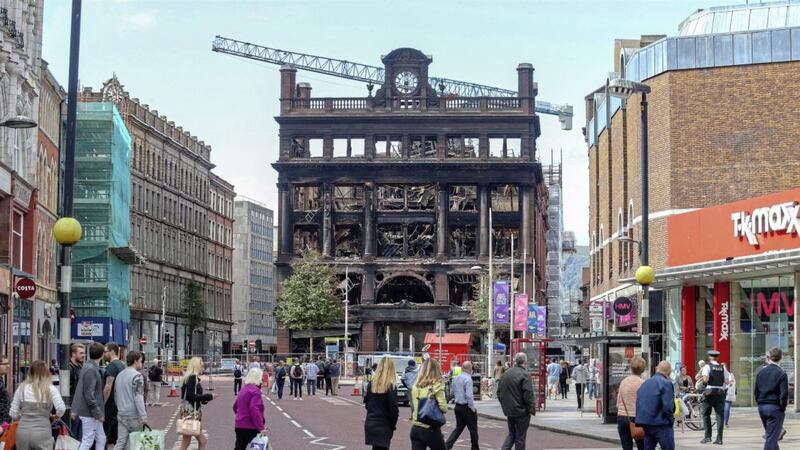I’VE no doubt the businesses surrounding the Bank Buildings on Belfast’s Royal Avenue were half hoping that the high winds of Storm Ali would topple its burnt-out facade. Like a black tooth in the mouth of the city, it defiantly stood intact after the storm, and while my heart goes out to those businesses affected, I don’t accept that knocking down what remains of the building is the answer.
Belfast’s stock of historical buildings of architectural note has been drastically reduced over the past century. Destruction done by the Luftwaffe in the 1940s was added to by bombings during the Troubles of the 1970s, 80s and 90s. This deliberate damage was exacerbated by a lack of thought when it came to rebuilding, with what Prince Charles once memorably described as ‘carbuncles’ replacing wonderful examples of Georgian, Victorian and Edwardian architecture.
Some argue they’re only buildings; I argue buildings are the exoskeleton in which we live – they matter because they act as the backdrop to our lives.
The sadness around the Bank Buildings fire was as much about memories as architecture. People related stories of using the front of Primark as a meeting point, while others talked of shopping trips with long-dead parents; the building acting as a reference point in their lives.
I know how they feel. I can’t pass Smithfield without remembering how it was and not what it has become – simply the back entrance to Castlecourt.
My childhood memories of the old Smithfield market are of a magical place; Belfast’s version of a kasbah where you could buy anything from a needle to a shrunken head. After it was burned down, Belfast City Council added salt to our wounds by replacing it with a tacky replica, exhibiting all the finesse of a public toilet.
On top of the unplanned demolitions of the 40s and 70s, our architecture has suffered under the influence of the unholy triumvirate of planners, politicians and property developers. We have all witnessed the modern-day miracle, where green belt suddenly turned into brown belt, as Belfast’s suburbs sprawled further into the surrounding countryside. Many planning decisions during the property bubble of the 1980s are hard to defend.
For example, what other city would allow the demolition of a Nobel Laureate’s home to make way for nondescript new-builds?
With a modicum of imagination and investment, Belfast could have developed a Seamus Heaney centre in his old family home on Ashley Avenue, housing a collection of the great man’s artefacts reflecting his years teaching at Queen's University. The opportunity went instead to Bellaghy, where the Seamus Heaney HomePlace brilliantly memorialises the great man’s legacy.
In Belfast, however, property developers were allowed to demolish Heaney’s home in 2002, ignoring not only local protestors but also the then Secretary of State John Reid and Environment Minister Dermot Nesbitt, who at the time said, "I say shame on the developer".
Sadly, with regard to planning, I feel little has changed over the intermittent 16 years. Living in north Belfast, I pass on a daily basis the small forest of cranes busily building the new Ulster University city campus. The latest building completed in the scheme is a housing unit for students, a block of red brick resembling a modern-day prison in the US.
Is it beyond the imagination of those entrusted with the construction of such public buildings to reach for aesthetics as well as function? Maybe today’s architects spent too much time playing with Lego as children and are thus incapable of designing anything but rectangles?
Not that I’d want all our old buildings retained – only an imbecile would reminisce about what once passed for social housing. Those two up, two down slums have thankfully been replaced today by homes of the highest quality and construction. We are also fortunate to still have such gems remain as the Grand Opera House, St George’s Market, the Crown Bar and Queen’s University.
And it would be churlish not to acknowledge those new buildings which are a welcome addition to our skyline. I cannot drive along the M3 and not glance at Titanic Belfast, a gleaming silver star on the banks of the Lagan. I also love the dome at Victoria Square, a marvel of glass and steel which shines like a jewel at dusk in the heart of Belfast.
These two triumphs of modern architecture will be cherished in our collective memory long after Ulster University’s Lego buildings have been demolished and forgotten.









